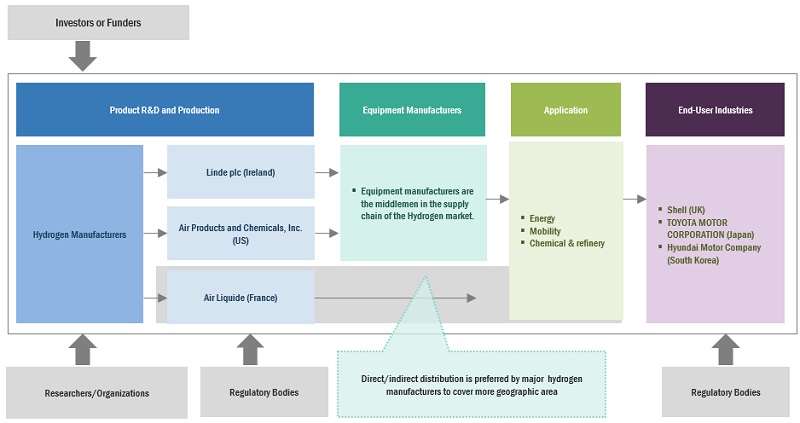Hydrogen is the lightest and most abundant element in the universe. Hydrogen gas has an excellent energy carrying capacity. It can be produced in large quantities and supplied to large-scale industries for various operations. It can be produced as a principal and by-product from various primary energy sources (such as wind, solar, coal, natural gas, and nuclear). Currently, hydrogen is produced in bulk for many value-added uses and chemical substances. It delivers power for various applications, including fuel cells and combined heat and power technologies. global push to reduce carbon emissions and combat climate change has led to an increased focus on clean and sustainable energy sources and drive the demand for hydrogen market.
The hydrogen market is projected to reach USD 410.6 billion by 2030 from an estimated USD 242.7 billion in 2023, at a CAGR of 7.8% during the forecast period.

Key Market Players
The major players in the hydrogen market include Linde plc (Ireland), Air products and Chemicals, Inc. (US), Air Liquide (France), Worthington Industries (US), Cryolor (France), Hexagon Purus (Norway), NPROXX (Netherlands).
Make an Inquiry @ https://www.marketsandmarkets.com/Enquiry_Before_BuyingNew.asp?id=132975342
This research report categorizes the hydrogen market by type, portability, application, and region.
On the basis of Sector, the hydrogen market has been segmented as follows:
- Generation Type
- Gray Hydrogen
- Blue Hydrogen
- Green Hydrogen
- Storage
- Physical
- Material-based
- Transportation
- Long Distance
- Short Distance
On the basis of application, the market has been segmented as follows:
- Energy
- Power Generation
- CHP
- Mobility
- Chemical & Refinery
- Petroleum Refinery
- Ammonia Production
- Methanol Production
On the basis of region, the market has been segmented as follows:
- Asia Pacific
- Europe
- North America
- South America
- Middle East & Africa
Recent Developments
- In July 2023, Air Products & Chemicals, Inc. announced that it has been chosen as the hydrogen and technology provider for Alberta’s first hydrogen fuel cell passenger vehicle fleet by Edmonton International Airport. Air Products will deploy a mobile hydrogen refueler at the airport to deliver hydrogen for the Toyota Mirai hydrogen fuel cell vehicle fleet.
- In July 2023, Air Liquide and KBR collaborated to provide fully integrated low-carbon ammonia solutions based on Autothermal Reforming (ATR) technology. Air Liquide is a global leader in ATR technology, which is one of the best options for large-scale production of low-carbon hydrogen (H2), which is then mixed with nitrogen (N2) to make low-carbon ammonia (NH3).
- In April 2023, Linde plc has signed a long-term arrangement with Evonik, a well-known specialty chemicals firm, to supply green hydrogen. Linde will build, own, and operate a nine-megawatt alkaline electrolyzer facility on Jurong Island in Singapore under this arrangement. This plant’s major output will be green hydrogen, which Evonik wants to employ in the synthesis of methionine, an essential element in animal feed.
- In April 2023, Air Liquide entered into an agreement with TotalEnergies to create an equally owned joint venture to develop a network of hydrogen stations. This initiative will help facilitate access to hydrogen, enabling the development of its use for goods transportation and further strengthening the hydrogen sector.
- In October 2022, Hexagon Purus and Lhyfe collaborated for the production of green and renewable hydrogen for transportation and industrial applications.
- In May 2022, Air Products Inc, OQ, and ACWA Power jointly signed an agreement for the world’s largest green hydrogen-based ammonia production powered by renewable energy.
The mobility segment, by application, is expected to be the fastest growing during the forecast period
This report segments the hydrogen market based on application into three segments: energy, mobility, and chemical & refinery. The mobility segment is expected to be the fastest growing during the forecast period. Owing to the rising adaption of the fuel cell electric vehicles and hydrogen fueling station. Due to the hydrogen fuel cell’s electrochemical reaction only producing water vapor as a byproduct, FCEVs have zero emissions. Due to this feature, FCEVs are a desirable alternative for both consumers and governments aiming to reduce air pollution and battle climate change.
Ask for Special Pricing @ https://www.marketsandmarkets.com/Enquiry_Before_BuyingNew.asp?id=132975342
North America is expected to be the largest region in the hydrogen market
North America is expected to be the largest hydrogen market during the forecast period. The North America region, comprising of US, Canada, and Mexico. Governments are dedicated to combating climate change and lowering greenhouse gas emissions. One important clean energy carrier that can aid in achieving carbon neutrality and promoting sustainable development is hydrogen, especially green hydrogen produced from renewable sources.


